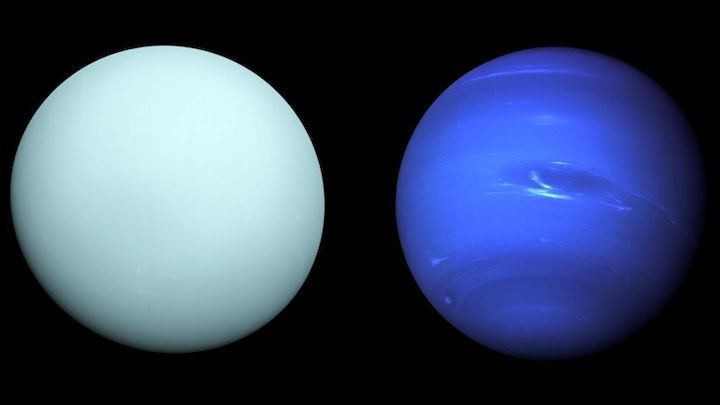4.03.2020

Uranus (left) and Neptune (right) as seen by Voyager 2, the only probed to have visited the planets.Credit: NASA/JPL-Caltech (L) and NASA (R)
Momentum is building among planetary scientists to send a major mission to Uranus or Neptune — the most distant and least explored planets in the Solar System. Huge gaps remain in scientists’ knowledge of the blueish planets, known as the ice giants, which have been visited only once by a spacecraft. But the pressure is on to organize a mission in the next decade, because scientists want to take advantage of an approaching planetary alignment that would significantly cut travel time.
Interest in the ice giants has grown exponentially, says Amy Simon, a planetary scientist at NASA’s Goddard Space Flight Center in Greenbelt, Maryland, who co-organized a meeting at the Royal Society in London in January, dedicated to exploring such a mission. NASA’s Voyager 2 is the only spacecraft to have visited Uranus and Neptune, in brief fly-bys in the 1980s. The ice giants therefore represent fresh territory for a wide range of researchers — for the study of planetary rings, atmospheres, moons and oceans, says Simon.
Jovian boost
The rare celestial alignment, between Neptune, Uranus and Jupiter, occurs next in the early 2030s, and would allow a spacecraft to slingshot around Jupiter on its way to the planets. This would reduce the travel time, and allow the craft to arrive well within the lifetimes of its instruments and power systems — usually around 15 years. It would also cut fuel mass, enabling the craft to carry a full suite of scientific instruments (see ‘Journey to the ice giants’). To take advantage of the alignment, a mission to Neptune would need to launch by around 2031 and one to Uranus by the mid-2030s.
Source: NASA
The window is “the right time to launch”, Mark Hofstadter, a planetary scientist at the Jet Propulsion Laboratory in Pasadena, California, said at the London meeting. “We don’t want to miss this one.” But the timing is tight. NASA is the most likely space agency to lead the kind of multibillion-dollar ‘flagship’ mission that scientists want. These typically take 7–10 years to prepare, and any green light from NASA would depend on the mission being prioritized in the agency’s Planetary Science Decadal Survey, which reports in 2022. A mission to Neptune or Uranus would also face competition from proposals to return a sample from Mars or explore Venus.
But whereas Mars and Venus scientists are building on decades of exploration, “Uranus and Neptune are genuinely out on their own, as we haven’t completed the very first phase of their exploration yet”, says Leigh Fletcher, a planetary scientist at the University of Leicester, UK, who co-organized the meeting.
Fletcher says that a mission to either planet should include going into orbit around it and sending at least one probe into its atmosphere or to one of its moons, as Cassini–Huygens, a joint mission by NASA and the European Space Agency (ESA), did for Saturn.
Blue mysteries
Scientists think of the two planets as twins because of their similar sizes and masses. But no one knows how similar they are, their composition or how they formed, Ravit Helled, a planetary scientist at the University of Zurich, Switzerland, told the meeting. Models struggle to explain the planets’ internal structures, or why more distant Neptune seems to be warmer than Uranus. Everybody assumes they are made of forms of water, or maybe ammonia ice, says Helled. “But actually we don’t really know that.”
A major mission to the ice giants would also benefit exoplanet studies, said Hannah Wakeford, an exoplanet scientist at the University of Bristol, UK. About 40% of known exoplanets are ice-giant-sized; understanding what these planets’ size and atmosphere reveal about their formation relies on understanding those in our own Solar System.
Delegates at the meeting agreed that they would be happy to visit either planet, because both would yield rich results. Studies show that it would be feasible to send probes from a mission to both planets, but this would be prohibitively expensive. Neptune is appealing because its moon Triton seems to be geologically active and might host a subsurface ocean, potentially of liquid water.
But Uranus — which has an unusual magnetic field that is tilted relative to the planet’s rotation axis — has more “odd” features than Neptune does, which challenge existing scientific models, said Hofstadter. The later launch window for Uranus also makes the planet a more realistic target, says Fletcher.
Too soon?
But some are concerned by the timescale. It is “the day after tomorrow” in space terms, Fabio Favata, head of strategy, planning and community coordination at ESA, told the meeting. The agency is already working on two major missions for the early 2030s, he said, so even if its forthcoming prioritization exercise, called Voyage 2050, recommends a visit to the ice giants, the agency could not make the launch window.
Alternatively, ESA could contribute to a NASA-led mission, but that would require a US decision, he added. Either agency could also send lighter, cheaper missions, for example to fly by one of the ice giants. These would produce valuable science, but not provide the comprehensive study that scientists hope for, said Hofstadter.
If planetary scientists miss the coming opportunity, then they will have to wait for the next alignment, in the mid-2040s, or rely on a more powerful launch system, such as NASA’s heavy-lift Space Launch System. But that technology is still in development.
Heidi Hammel, a planetary astronomer and executive vice-president of the Association of Universities for Research in Astronomy in Washington DC, flagged another issue scientists might face with a mission to Uranus: jokes about the planet’s name. “I’m sorry I’m saying this. But I really do think that’s a legitimate problem we would face,” she said.
Quelle: nature

